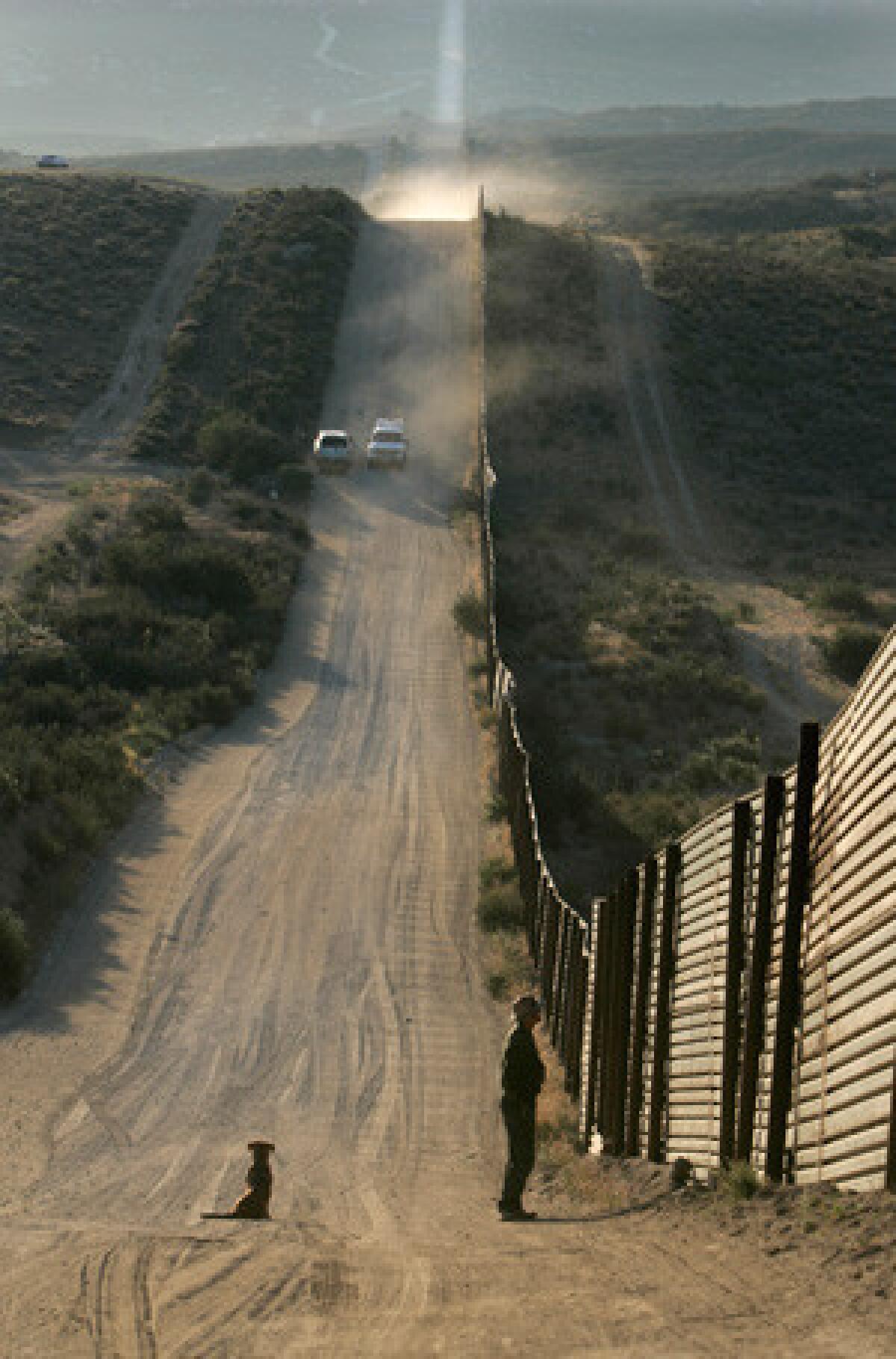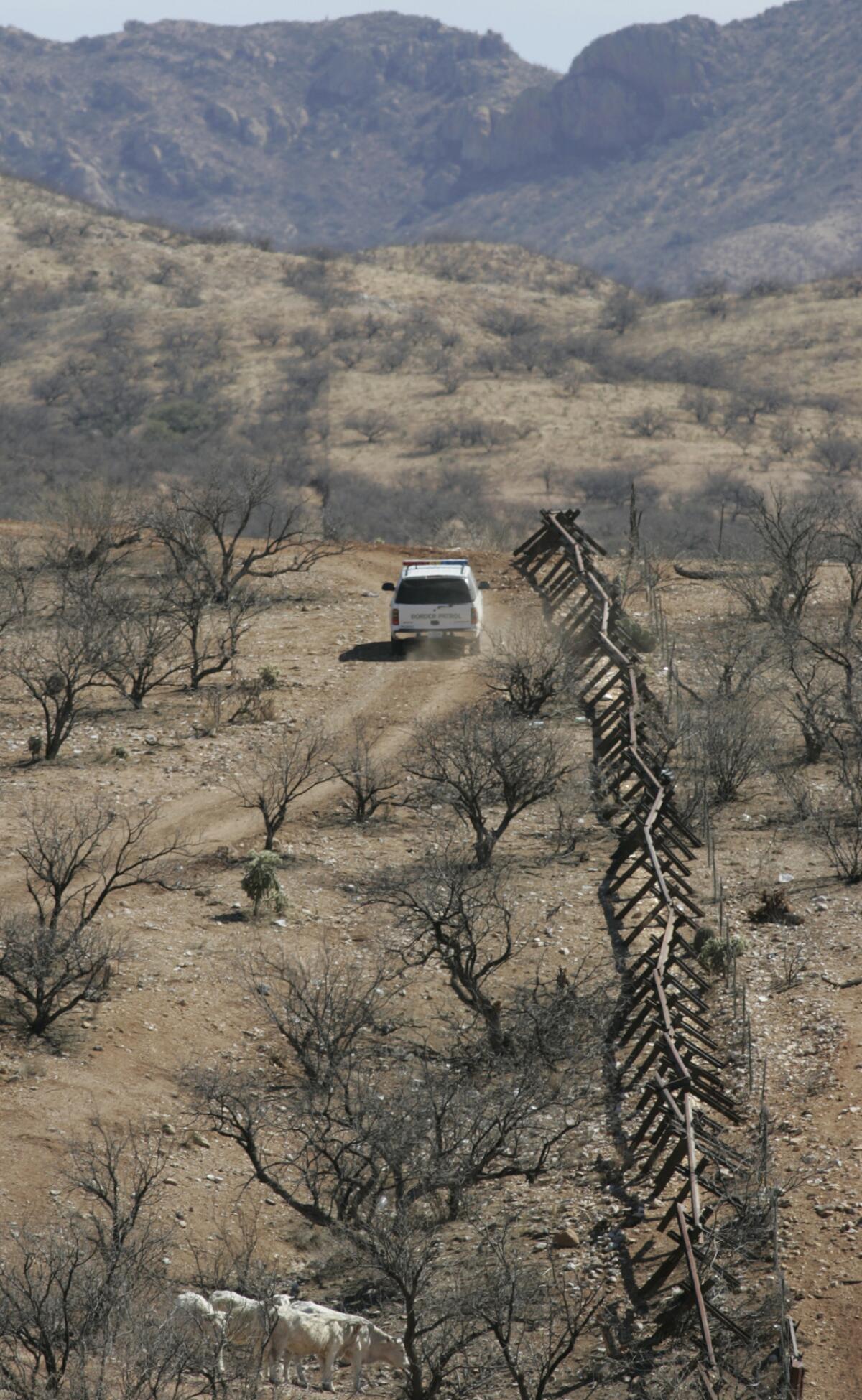Immigration reform’s first hurdle: Is the border secure?
Despite barriers, migrants are still getting across, although the flow has slowed. The debate now is whether the government can do more, and pay for it.
- Share via
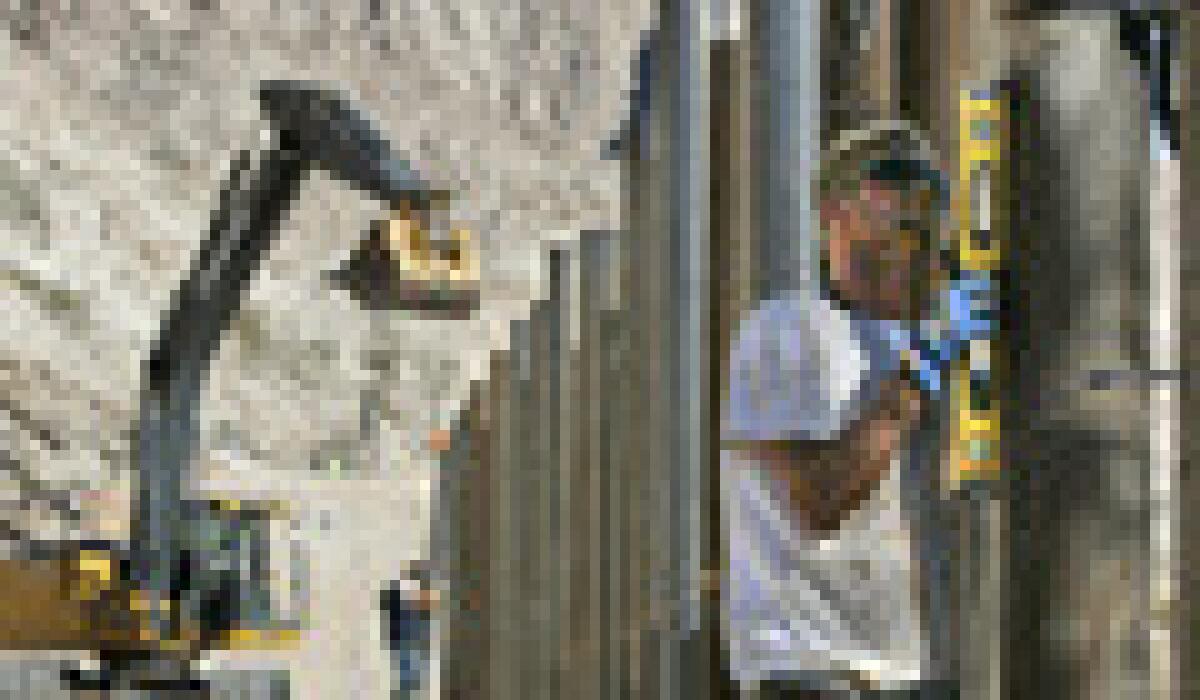
The border barriers rise out of the Pacific Ocean, climb craggy California peaks, streak across Arizona desert valleys and meander through cattle ranches and fields of sorghum and citrus in South Texas.
Tall steel fencing separates border communities. Camera towers and bright rows of stadium lights aim at smugglers' enclaves in Mexico. Migrants seeking out traditional crossing routes find them blocked, and many give up.
But migrants still get across, by seeking out the one road or one mountain range or one desert trail beyond the reach of the U.S. Border Patrol.
Scenes like these form the bedrock of the immigration reform debate in Washington. The Obama administration backs a pathway to citizenship for more than 11 million illegal immigrants, and a bipartisan group of U.S. senators is working on legislation to make it happen. But first, the eight senators have agreed, the border must be certified as secure.
Memories are still fresh of the reforms of 1986, which led to citizenship for 3 million undocumented immigrants but did not strengthen the Mexican border. Millions of migrants poured through in the ensuing years, making a mockery of claims that the immigration problem had been solved.
Failure now to agree on the definition of a secure border, and on how much money to spend to achieve it, would probably kill the current reform movement.
Obama administration officials claim the frontier is more secure than ever, benefiting from the billions of taxpayer dollars spent on border defenses. There are 18,500 U.S. Border Patrol agents on the U.S.-Mexico border now, compared with 3,222 in 1986. Barriers have been built along nearly 700 miles. In 1986, most of the frontier was wide open.
Arrests of migrants have hovered around 350,000 per year recently, the lowest level since the 1970s. Falling crime rates in border communities make them some of the safest in the country. Authorities have regained control of once-trampled areas, opening the way for new subdivisions, shopping centers and industrial parks.
"We have gone above and beyond what was requested by the very Republicans who said they supported broader reform as long as we got serious about enforcement," said President Obama during a trip to the border at El Paso in 2011. "All the stuff they asked for, we've done."
But critics consider some recent gains illusory. Migrant flows have receded overall because of the lack of jobs in the U.S. The true test will come when the economy improves, they say.
Some current and former border officials doubt defenses will hold completely, especially because certain areas remain porous. They say more enforcement measures are needed. One of the critics' oft-cited facts: There are fewer agents patrolling a nearly 2,000-mile border than there are cops, about 34,500, in New York City.
Border security is still a work in progress, said Ronald Colburn, a former chief U.S. Border Patrol agent. "We're not there yet. The border is still a high-risk situation," said Colburn, who oversaw some of the fence construction. Migrant arrests, which topped 120,000 in Arizona alone last year, he said, remain at worrisome levels.
Homeland Security officials express frustration at what they consider unrealistic expectations. Because accurate measurement of migrant traffic has always been elusive (how can migrants be counted if they're not caught?), security levels will always be open to interpretation.
The standards demanded by some lawmakers are unattainable, no matter the investment. "Even the heaviest concentration of fencing, all-weather roads, 24-hour lighting, surveillance systems and Border Patrol agents cannot seal the border completely," U.S. Border Patrol Chief Michael Fisher recently told Congress.
Down along the endlessly varied terrain and ever-shifting flows of migrant traffic across the 1,954-mile U.S.-Mexico border, the picture is decidedly mixed, giving ammunition to both sides to make their arguments. Keep reading »
Sources: GAO, U.S. Border Patrol, U.S. Coast Guard, ESRI
Graphics reporting by Richard Marosi, Interactive graphic by Armand Emamdjomeh
'Melt zones'
When the federal government moved to control the border in the 1990s, it focused on America's frontier towns and cities. In enforcement parlance, such communities are called melt zones, places where homes and shops lie but a quick sprint away from Mexico. Migrants who breach the border can slip amid the bustle of pedestrians and traffic, melting into the U.S.
Those who argue that great strides have been made in securing the border point to the melt zone cities as evidence.

The U.S.-Mexico border bisects this aerial view, with the cities of Mexicali, Mexico, at the top and Calexico, Calif., at the bottom. (Don Bartletti/Los Angeles Times)
The melt zone in the California town of Calexico lies across 1st Street from the Baja California city of Mexicali. In 1999, border authorities erected a 15-foot steel barrier dividing the cities. It wasn't intended to stop migrants, just slow them enough for agents to respond.
For many years, there weren't enough agents to chase down fence jumpers. Then authorities added more layers of enforcement, including video surveillance cameras and, in the late 2000s, hundreds of new agents.
When migrants scale the fence these days — using ropes or ladders or simply climbing atop one another's shoulders — agents often get there within seconds, say residents and migrants.
"One agent calls another and another and another, they converge and catch the person," said Mariela Vega, whose picket fence on 1st Street was destroyed years ago by agents pursuing a migrant. "Hardly anyone gets across anymore."
At a shelter in neighboring Mexicali, migrants plot ways to cross into the U.S, but scaling the barrier is not considered a realistic option, though it's just three blocks away. People are usually caught and deported, David Vera, 25, a migrant from Guanajuato, said in February.
"It looks easy, but it's not," said Vera, gazing out at Calexico from the windows of the shelter.
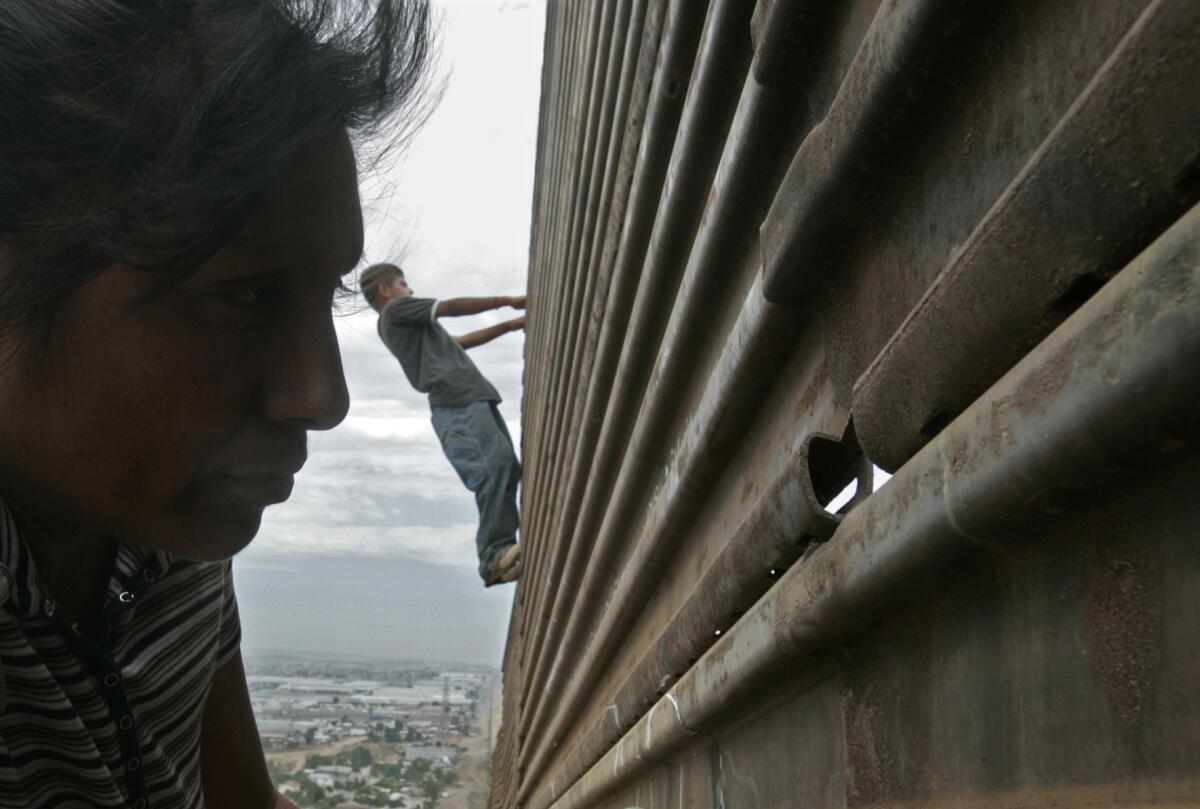
After miles of steel panels were welded together with the ribs positioned horizontally, the U.S. Border Patrol realized how easily migrants could scale the 10-foot barrier. Much of that fencing, erected in 1990s, has been replaced. (Don Bartletti/Los Angeles Times)
Wanting to test border patrol alertness, another migrant, Jorge Luis Robledo, 23, said he threw a cat over the fence. "After it hit and landed on the ground, a bunch of agents showed up thinking it was a person," said Robledo, a deportee from Brownsville, Texas.
The cat scurried away. Robledo walked back to the shelter. "I realized then that I can't cross here," he said.
Similar approaches using layered enforcement significantly slowed illegal immigration in most other populated areas, including the border's biggest cities of El Paso and San Diego.
Once besieged with migrants running en masse down freeways, San Diego is now one of the toughest places to make illegal crossings. The fortifications, the most extensive of any border city, include triple fencing, some of it topped with razor wire.
Critics pointed out that the border defenses in the cities only served to push migrants to the deserts and mountains. The deteriorating situation in remote areas led in part to the passage of the Fence Act of 2006, which authorized the construction of hundreds of miles of barriers.
In 2007, trucks delivered hundreds of tons of steel to the desert outside Yuma. Within one year, a fence stretching 32 miles — some of it consisting of solid steel sheets that burn skillet hot — was completed, becoming one of the longest stretches of continuous fencing on the border. The fence was considered one of the most successful built in those years and contributed to the most dramatic drop in arrests anywhere on the border, from 138,000 in 2005 to 6,500 in 2012.
Some of the new fencing reinforced areas flanking San Diego. One barrier zigs and zags along the steep slopes of Otay Mountain. Another barrier rises atop Smugglers' Gulch, a once-notorious canyon where the steep slopes are buried under thousands of truckloads of dirt. And a barrier was built 300 feet into the Pacific Ocean, cutting off easy access to Imperial Beach.
Odd placements
In a string of towns across South Texas, fencing completed in recent years divides communities in the U.S. The barrier in Brownsville, for instance, cuts through agricultural fields and neighborhoods, leaving some residents stuck living south of the fence but north of the actual border.
In Eagle Pass, the picket-fence-style steel barrier runs through a park, flea market and golf course, with gates cut in the barrier to allow golf carts through.

A resident east of Brownsville, Texas mows grass along the border fence that's hundreds of yards north of the U.S.-Mexico border line. (Don Bartletti/Los Angeles Times)
The odd fence placement illustrates the challenges of building barriers along a border delineated by the twists and turns of the Rio Grande. It also plays into the border debate in the most practical of ways: Sometimes what looks possible on a chart poses daunting challenges on the ground.
In avoiding the river's flood plain, barriers had to be erected as far as one mile north of the actual border. Much of the land was privately owned and had to be seized by the federal government over the protests of landowners.
The approximately 60 miles of fencing is not continuous. There are large gaps to allow access for residents and ranchers. That creates opportunities for migrants.
One Saturday last month in Eagle Pass, one of the gates stood open as golfers teed off on a nearby green and parents watched children on a playground and herded others to a Little League ball field.
It was pointless to build it when it's not secure all around. It's like putting a dog in a cage with an opening.”— Jose Duran, Eagle Pass police officer
"It was pointless to build it when it's not secure all around," said Jose Duran, 35, an Eagle Pass police officer arriving with his son for a Little League game. "It's like putting a dog in a cage with an opening."
Farther south from Eagle Pass, in the Rio Grande Valley city of McAllen, agents say the barriers make it easier to round up illegal crossers.
"What we've seen is the border fence is very effective at funneling traffic into those gaps," said Rosendo Hinojosa, the chief patrol agent for the agency's Rio Grande Valley sector.
The Rio Grande Valley area remains one of the Border Patrol's most problematic regions. Arrests jumped more than 60% in 2012, to 97,000, still less than half of the peak year totals in the late 1990s.
Crossing Arizona
If illegal crossing routes were mapped, most paths would cut through Arizona. The state was overwhelmed with undocumented immigrants after California's border was reinforced in the 1990s. Tucson and Phoenix became the top destinations for migrants, prompting the state to pass tougher immigration laws that inspired similar legislation and provoked intense opposition across the country.
In recent years, federal officials pointed to sharply falling arrest rates as evidence security had improved in Arizona. But it is also here that critics of the latest reform effort draw some compelling anecdotal evidence that the government has more to do.
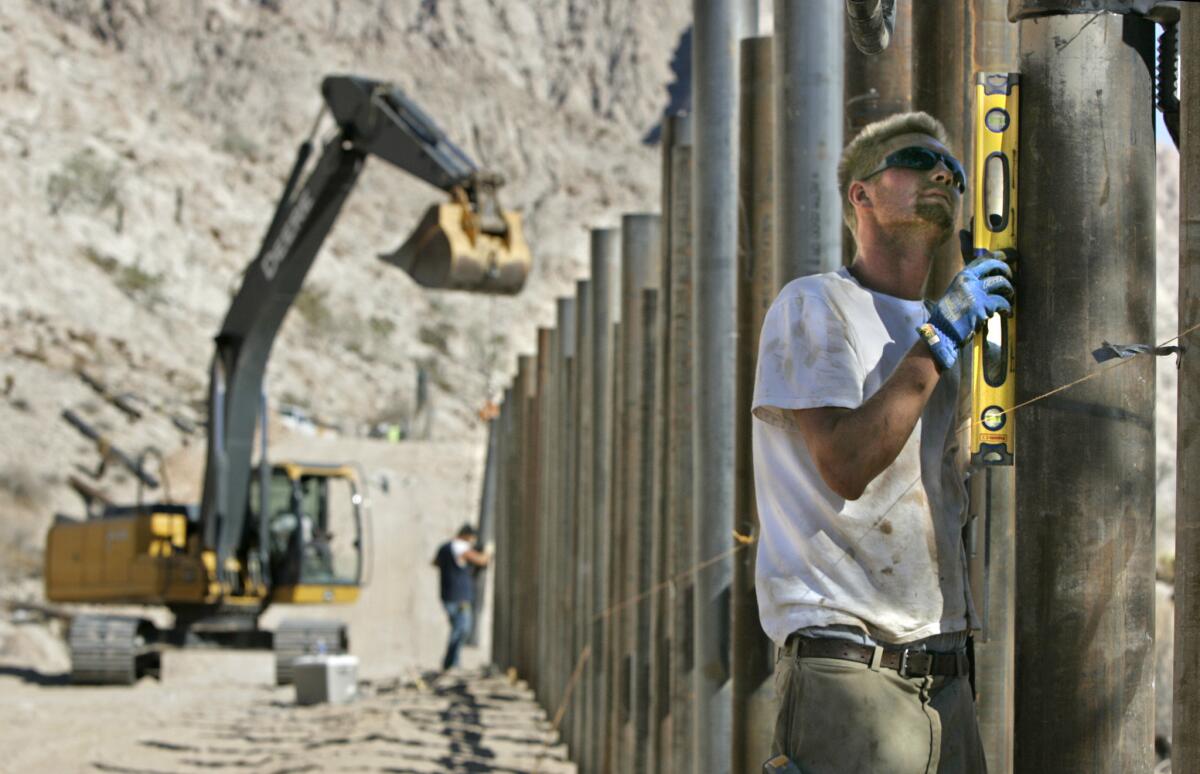
Forty miles into the desert east of San Luis, Ariz., Dan Anskate checks the level of a 12-inch-diameter steel fence post. All new fences along the border must be able to withstand a 40-mph impact from a vehicle. (Don Bartletti/Los Angeles Times)
The federal government has dramatically increased the number of agents in the state, to more than 5,000. It has installed barriers along about 80% of Arizona's border. It expanded and built stations and established small encampments, called forward operating bases, in areas so remote that terrain resembles moonscapes and agents are sometimes flown in by helicopter.
In a mountainous region west of Nogales without sturdy fencing, migrants and smugglers regularly slip onto the 50,000-acre cattle ranch of Jim and Sue Chilton.
Wadded-up socks and sun-bleached water bottles litter the Chiltons' land, and the four-string barbed-wire fence is frequently trampled. Last year, the fifth-generation rancher chased off AK-47-toting drug smugglers with a 12-gauge shotgun that he calls "Old Trusty."
"The druggers keep coming and they're the scary ones," Chilton, 73, said.
The Border Patrol has tried to increase its presence here, but the rugged topography hampers efforts. Camera towers send images to Tucson, but they capture only a portion of the terrain. The gullies and washes seem designed for smuggling.
In recent years, the Border Patrol established a forward operating base near the Chiltons' property. From two trailers, staffed around the clock, agents were within striking distance of the border, instead of an hour's drive from the nearest patrol station.
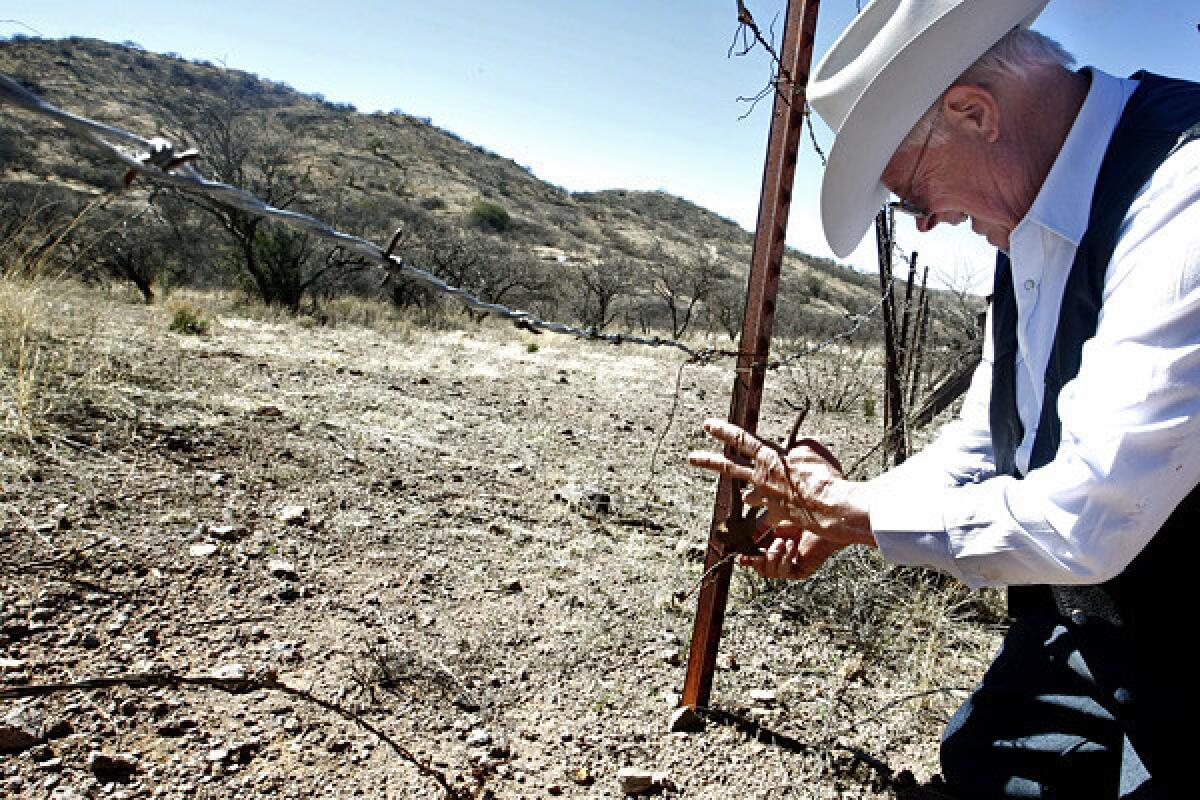
Cattle rancher Jim Chilton repairs the barbed-wire fence where his ranch shares the border with Mexico about 19 miles south of Arivaca, Ariz. Cartel drug runners and illegal migrants cut the wire almost every day. (Don Bartletti/Los Angeles Times) Video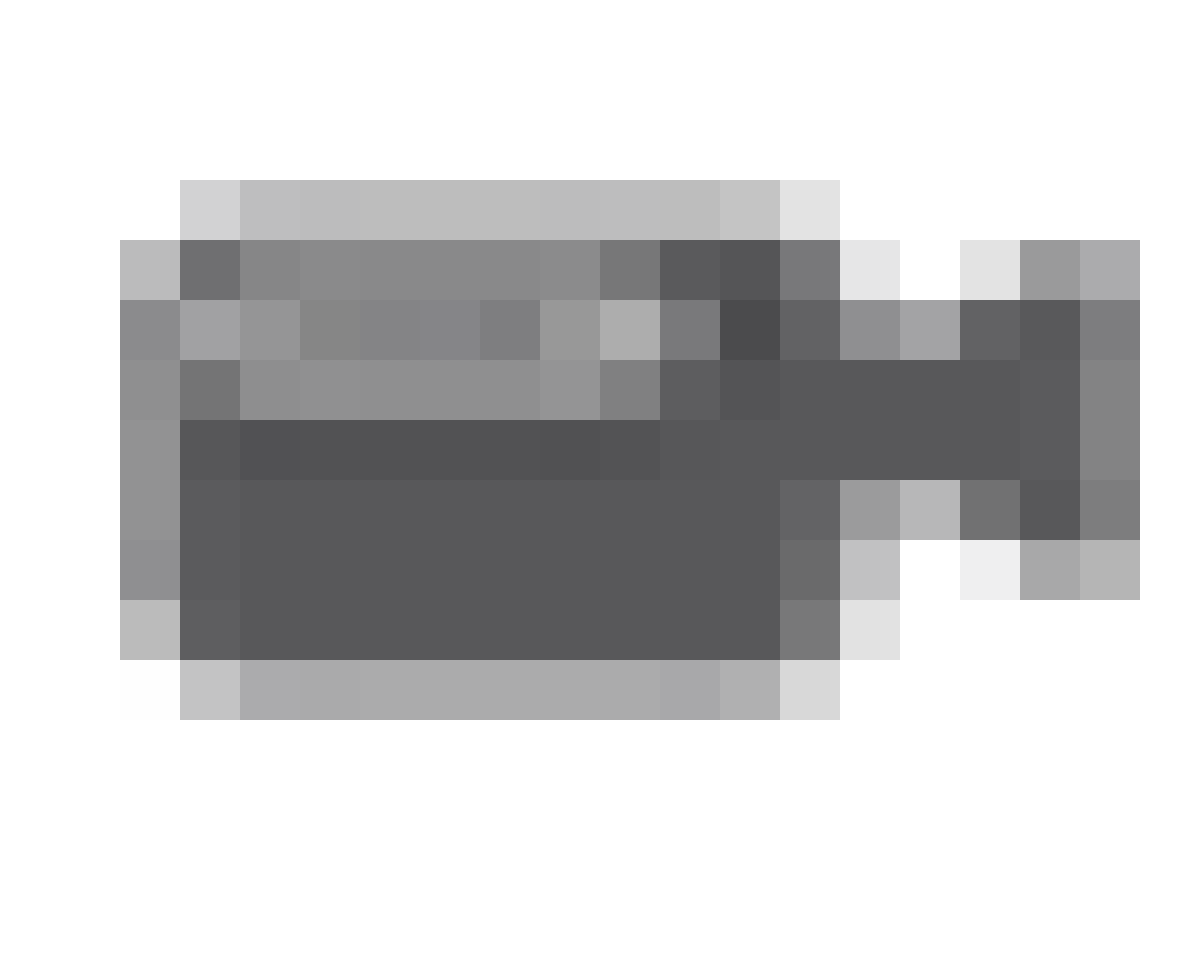
Chilton said it made a difference. But the base was shut down because of shrinking budgets.
"Here we are in one of the most trafficked areas, and it's abandoned," Sue Chilton said, shaking her head in disappointment as she walked around the perimeter of the empty trailers. Two chairs, a barbecue and a picnic table had also been left behind.
Federal authorities say the focus on remote pockets distorts the overall picture. For every worried rancher, there are thousands of people in populated communities who cite dramatic improvements, they say. Reform advocates mention the enormous costs necessary to secure rural areas like the Chilton ranch.
"What sort of force would it take to patrol a 50,000-acre ranch, especially at night?" said Adam Isacson, a policy expert for the Washington Office on Latin America, in a post for the group's Border Fact Check blog.
People on both sides of the debate are wary of lawmakers who focus solely on border security. The illegal immigration problem, they say, can never be solved entirely at the border. Until comprehensive reform is enacted, including stronger enforcement against employers who hire undocumented immigrants, migrants will keep trying to cross.
"We have made progress, significant progress," said Peter Nunez, a former U.S. attorney in San Diego. "You can do more on the border, but the biggest problem now is the workplace."
Contact the reporters | More: Without a Country | Back to interactive map
Sign up for Essential California
The most important California stories and recommendations in your inbox every morning.
You may occasionally receive promotional content from the Los Angeles Times.
